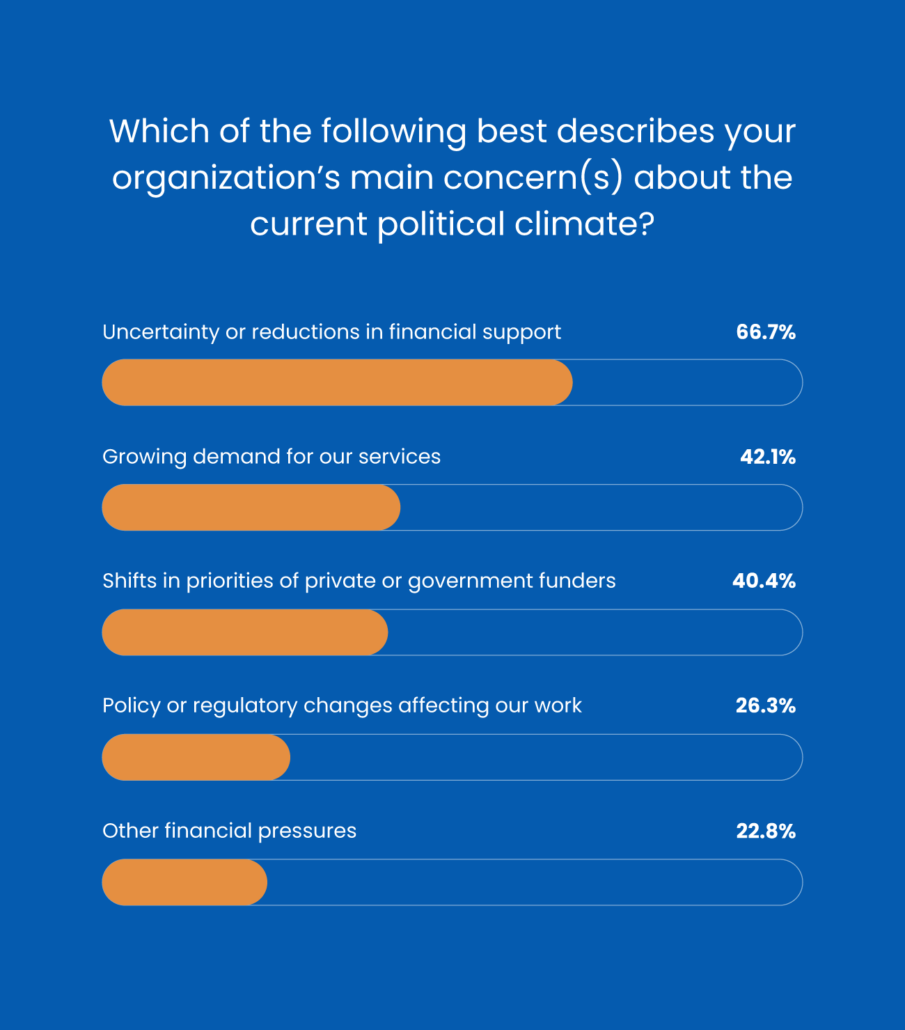At Next Stage, we’re always listening for the signals beneath the noise. And right now, those signals are blaring.
We recently surveyed nonprofit and social good leaders to better understand how today’s political and economic shifts are impacting organizations on the ground. Among 57 respondents, 96% shared that they are struggling with pressing concerns that have already impacted, or are anticipated to impact, their institutions, and 67% of respondents cited financial instability as their top concern.
From potential cuts to Medicaid, HUD, and DOE funding to uncertainty around state and local municipality spending in the wake of these cuts, the effects of federal policy changes are immediate and, in many cases, destabilizing.
This is a crisis, full stop. And its ripple effects are showing up in breakroom conversations, Zoom calls, and staff meetings. The stress of so many unknowns, paired with the near-daily disruption of policy change, is wearing on teams — especially those working closest to vulnerable communities. Internal culture is under strain, and social good leaders must respond.
People are tired and stretched thin. And the hardest part? We may only be at the beginning of what could be a prolonged period of disruption.
Though the challenges ahead may seem daunting, history has shown that mission-driven organizations often find their greatest innovation and community impact during periods of adversity, especially when they invest in their people and culture.
Here are 3 ways to take action today:
1. Create Space for Honest Dialogue
Many staff members are carrying anxiety — about their jobs, the communities they serve, and the future of their organization. It’s tempting to try to shield teams from instability, but silence can breed more fear than transparency. Simply naming the uncertainty can go a long way in maintaining trust and cohesion.
This is particularly true for the people on the front lines of your program delivery — those most proximate to the needs your institution aims to address. Creating opportunities to listen to your employees is something we advocate for through our Community Voice work because it’s a powerful way to build a sense of belonging within your organization, which can help strengthen organizational culture and retain staff.
So aim to create intentional moments for dialogue. Host monthly listening sessions where staff can ask questions and share concerns. If you’re not ready for whole-group conversations, start with anonymous feedback tools that give employees a place to safely speak their minds. It can be as simple as a suggestion or question box in the break room or regular office hours for private conversations. The key is to always close the loop by acknowledging what you’ve heard and outlining what actions (if any) you’ll take.
2. Reaffirm Your Organizational Values
Are your values and guiding principles negotiable? That’s the question many leaders are grappling with, especially as language around diversity, equity, inclusion, and belonging (DEIB) is increasingly politicized. Some funders are distancing themselves from terms that were once celebrated. But changing your language doesn’t mean changing your values.
To keep your team grounded and aligned, consider revisiting your values statements as a group. Facilitate a conversation about what’s essential and nonnegotiable. Turn those into a clear and simple “Values-in-Action” document that can guide communications, grant writing, and external messaging. When everyone is on the same page, it’s easier to move forward with integrity and unity, even in challenging times.
Something to keep in mind: creating an appropriate response to current conditions will be a unique process for each institution. An organization’s size, mission focus, and funding sources will all affect its risk tolerance and next steps.
As you prepare for these important internal conversations, here are two pieces of information to consider:
- Despite sensationalized claims of “DEI fatigue,” recent research shows only 17% of consumers strongly support DEI cutbacks, with the majority being unsupportive or neutral. Similarly, 85% of consumers do not support companies reducing charitable giving. While public opinion doesn’t directly dictate corporate or federal policy, it provides a useful indicator of broader social sentiment and potential customer/donor reactions.
- Rev. Bernice A. King (daughter of Martin Luther King Jr.) recently offered valuable advice for nonprofits feeling threatened: remain attuned to the federal government while strategizing quietly and choose language carefully. As she notes, “Everybody has to start looking at language. It doesn’t mean you have to do away with your core mission, but you’re going to have to wordsmith to get through this season… people are going to have to look at ways to be creative.”
No matter what approach you take with your messaging, the key is aligning your team. Because when your team rallies around clearly articulated values, you create a resilient organizational culture that can weather external pressures while staying true to your mission’s heart — regardless of the terminology you choose to express it.
3. Build Confidence Through Contingency Planning
When the future feels uncertain, preparation is a powerful antidote to fear. It’s not about having all the answers, but it is about showing your team that you’re thinking ahead.
Start by outlining a few “what-if” scenarios tied to your current funding structure and program delivery. Bring in department leads or cross-functional teams to help develop response strategies. Consider creating a short internal playbook with draft responses, decision-making frameworks, and communication plans. Even small steps, like naming a contingency planning team or conducting a tabletop exercise, can reassure staff that leadership is proactive and not reactive.
To help shape these efforts, check out resources like this one from Bridgespan. Want more hands-on guidance? Reach out today to see how our team can help.
Above all, we think a key to navigating the future will be collaboration, and that includes partnering with your internal team to wayfind together. Now is not the time for “heroic leadership” — instead, incorporate your direct reports to ensure they feel seen, heard, connected, and inspired to tackle what is coming next.
Nonprofit leaders: We believe in your courage. We believe in your determination not to let the future be written for you.
That’s why we invite you to continue this learning journey with us through our monthly 2-minute survey series. Because this conversation is just getting started, and your voice is needed to help shape effective solutions for the nonprofit community.
Up next, we’re exploring how external challenges are affecting internal operations and staff.
See a comprehensive report of last month’s survey results here, and follow us on social media to stay in the loop on future findings.
![]() Want the latest social good trends, insights, and inspiration delivered straight to your inbox? Subscribe to the Impact Insider today!
Want the latest social good trends, insights, and inspiration delivered straight to your inbox? Subscribe to the Impact Insider today!


